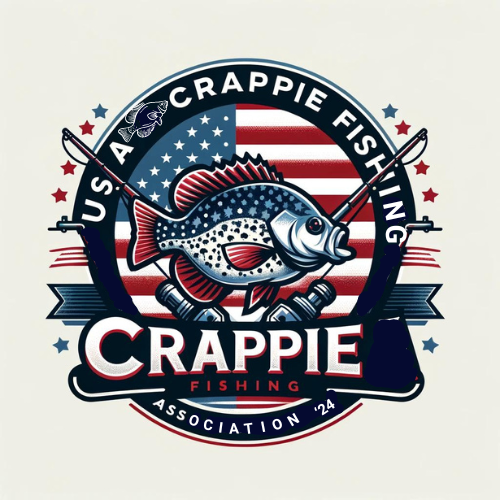“Fishing is much more than fish. It is the great occasion when we may return to the fine simplicity of our forefathers.” – Herbert Hoover
When it comes to crappie fishing, selecting the right lure color can make all the difference between a successful day on the water and going home empty-handed. Crappie lures come in a wide array of colors, each with its own appeal and effectiveness in specific conditions. By understanding the role of color in attracting crappies and adapting your lure choice to the prevailing conditions, you can significantly improve your chances of landing that prized catch.
Key Takeaways:
- Choosing the right lure color is crucial for success in crappie fishing.
- Bright colors, like chartreuse, are effective on sunny days when crappies seek shade.
- Natural colors, such as white and gold flake, work well in clear water conditions.
- Dark colors, such as black and chartreuse, are ideal for muddy or stained water.
- Observing crappie behavior and adapting lure colors using forward-facing sonar can lead to better results.
The Importance of Color in Crappie Fishing
Experienced crappie anglers know that color plays a significant role in attracting and triggering strikes from crappies. While some may think that any color will work, experts suggest that selecting the right color based on the prevailing conditions can greatly improve your chances of success.
Bright Colors for Sunny Days
On sunny days, crappies tend to seek shade and cover. The bright sunlight can make them more cautious and hesitant to venture into open water. However, using bright colors for your lures can help draw their attention and trigger strikes.
One particularly effective bright color for sunny days is chartreuse. This vibrant hue stands out in the water, making it highly visible to crappies even in bright conditions. Anglers have reported success with colors like hot pink, hot orange, and of course, chartreuse, when fishing in open water or areas with shade-producing structures.
“I’ve had great success using bright colors like chartreuse on sunny days. It seems to catch the attention of crappies and entice them to strike.”
– Kevin Johnson, experienced crappie angler.
When the sun is shining, remember to reach for your lures in bright colors. Their eye-catching appearance can help overcome the challenges of sunny days and increase your chances of landing a trophy crappie.
Benefits of Using Bright Colors on Sunny Days:
- Increased visibility in bright conditions
- Attracts the attention of cautious crappies
- Effective in open water and areas with shade-producing structures
| Bright Colors | Benefits |
|---|---|
| Chartreuse | High visibility; attracts crappies in bright conditions |
| Hot Pink | Eye-catching color; triggers strikes in sunny conditions |
| Hot Orange | Standout color; entices crappies to strike in sunny areas |
Natural Colors for Clear Water
In clear water, selecting the right color for your crappie lure can make a significant difference in your fishing success. Crappies have sharp vision and can easily detect unnatural colors, so it’s important to use natural-looking hues that closely resemble their natural forage. Popular choices for clear water conditions include shades of white, gold flake, and pearl.
These natural colors mimic the appearance of baitfish, which are a staple in the crappie’s diet. By imitating their prey, you can entice crappies to strike and increase your chances of a successful catch. Whether you’re using jig heads, soft plastic baits, or other lures, incorporating natural colors into your crappie fishing arsenal is key.
| Color | Description |
|---|---|
| White | A crisp and clean color that resembles small baitfish. |
| Gold Flake | A metallic color with specks of gold, creating a shimmering effect. |
| Pearl | A subtle iridescent color that imitates the sheen of baitfish scales. |
Why choose natural colors in clear water?
Clear water provides excellent visibility, allowing crappies to closely inspect potential food sources. In these conditions, using lures with natural colors increases the likelihood of fooling crappies into striking. By presenting a bait that closely resembles their natural prey, you can trigger their predatory instincts and prompt them to bite.
Using natural colors in clear water helps crappies perceive your bait as a genuine food source, increasing their interest and enticing them to strike. It’s like offering them an irresistible feast they simply can’t resist.
Experimenting with different shades and combinations of natural colors can also be effective in clear water conditions. Keep in mind that factors such as water clarity, sunlight intensity, and the presence of vegetation or structure may influence the crappie’s feeding behaviors and color preferences. Observation and adaptation are essential in finding the right natural colors that work best for your local fishing spots.
- Using white-colored baits in clear water can be particularly effective, as it closely resembles the natural coloration of many baitfish species.
- Gold flake adds a flashy element to your bait, making it more visible and enticing to crappies in clear water.
- Pearl-colored lures have a subtle and realistic appearance, imitating the shimmering scales of baitfish.
By incorporating these natural colors into your tackle box and experimenting with different presentations, you can increase your chances of success when fishing for crappies in clear water.
Dark Colors for Muddy Water
In muddy or stained water, crappies rely heavily on their lateral line for detecting prey. The reduced visibility in murky conditions makes it essential to use lures that stand out and create a strong contrast. Dark colors are known to be effective in such situations, as they provide better visibility for the fish. Two popular combinations for crappie fishing in muddy water are black and chartreuse or black and hot pink.
The black color helps create a silhouette against the muddy backdrop, making it easier for crappies to spot the lure. Meanwhile, the bright chartreuse or hot pink color provides a vibrant contrast, grabbing the attention of these fish with their lateral line senses. This combination is particularly effective in low-light conditions or areas with heavy sedimentation.
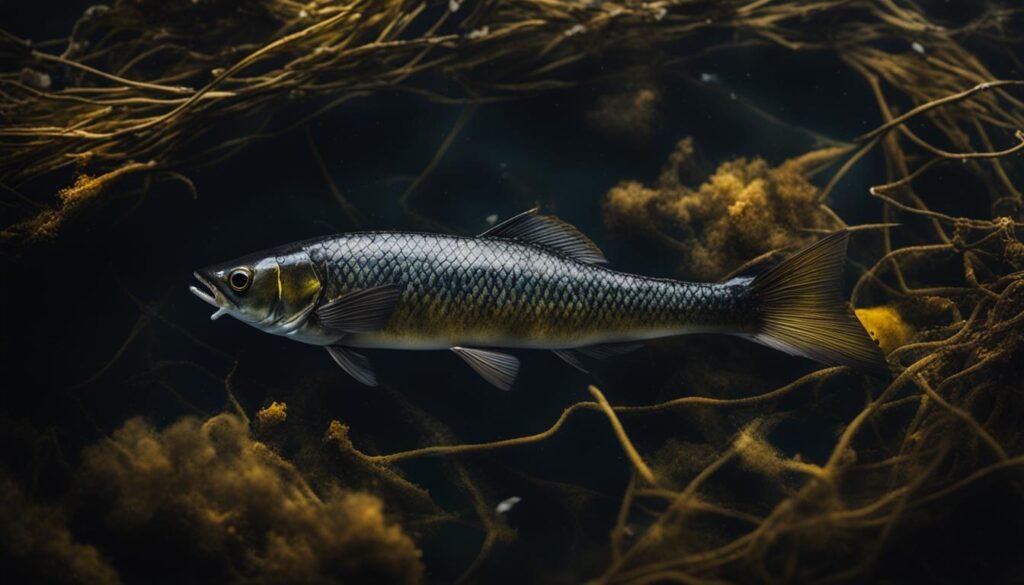
Using these dark color combinations can significantly increase your chances of attracting crappies in muddy water. Remember to experiment with different retrieves and incorporate subtle movements to simulate the natural behavior of prey. By offering a visually appealing target, you are more likely to entice strikes from these fish even in challenging conditions.
Continue reading to discover more expert tips and recommendations on selecting the best crappie lure colors for various conditions.
Observing Crappie Behavior with Forward-Facing Sonar
Advances in fish-finding technology, like forward-facing sonar, allow anglers to observe how crappies respond to their bait in real-time. With this innovative tool, you can gain valuable insights into crappie behavior and tailor your fishing approach accordingly.
One renowned expert in the field, Todd Huckabee, a professional crappie angler, shares his insights on using forward-facing sonar:
“When you’re using forward-facing sonar, you can see whether crappies are showing interest in your bait or ignoring it. If they are not reacting favorably to a certain color, it’s time to switch to a different color. This real-time observation allows you to make quick adjustments and increase your chances of success.”
By utilizing forward-facing sonar, you can pinpoint the color preferences of crappies in a specific location and adapt your lure selection accordingly. This comprehensive understanding of crappie behavior enables you to make informed decisions on color choices based on real-time observations.
Benefits of Forward-Facing Sonar for Crappie Fishing
The advantages of using forward-facing sonar in crappie fishing are plentiful. Here are some key benefits:
- Real-time visualization: Forward-facing sonar provides instant feedback on how crappies react to your bait, allowing you to assess their behavior without delay.
- Accurate lure presentation: With forward-facing sonar, you can fine-tune your lure presentation to match the crappie’s preferences, increasing your chances of enticing strikes.
- Efficient bait color experimentation: Instead of relying solely on trial and error, forward-facing sonar allows you to test different lure colors and gauge the crappie’s response, saving you time and increasing your success rate.
By integrating forward-facing sonar technology into your crappie fishing arsenal, you can gain a competitive edge and enhance your understanding of crappie behavior.
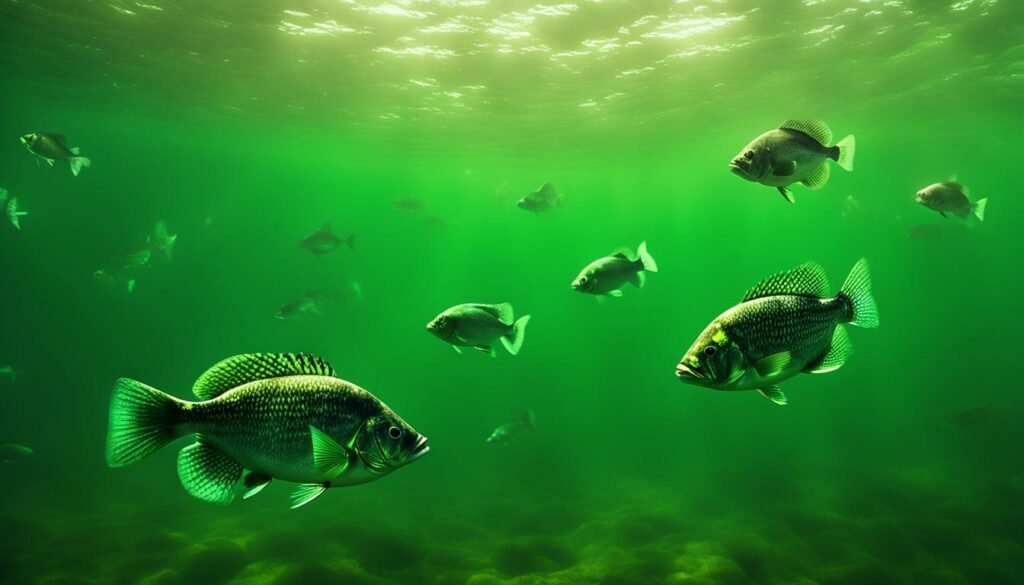
Expert Picks for Top Crappie Lure Colors
When it comes to crappie fishing, experienced anglers have their favorite lure colors that consistently produce results. Below are some expert picks for the top crappie lure colors:
“Monkey Milk”: This popular color combines a white body with darker speckles, imitating the appearance of small baitfish. It works well in a variety of conditions and is particularly effective in slightly stained or murky water.
“Blue Ice”: With its blue and white combination, this color closely resembles the look of a natural shad. It performs exceptionally well in clear water and sunny conditions, attracting crappies with its realistic appearance.
“Blue Thunder”: The vibrant blue color of this lure mimics the flash and shine of a minnow, making it irresistible to crappies. It is a top choice for fishing in both clear and slightly stained water.
“Pearl White”: This classic color option is a staple in many crappie anglers’ tackle boxes. Its simplicity and versatility make it a go-to choice for various water conditions, especially when fishing in bright sunlight.
“Threadfin Shad”: Designed to imitate the look of a threadfin shad, this color features a silvery white body with a touch of blue. It is highly effective in clear water, especially when crappies are actively feeding on shad.
“Electric Chicken”: This bold and eye-catching color combination of chartreuse and bubblegum pink is a favorite among anglers targeting crappies. It works well in both clear and stained water, attracting aggressive strikes.
These expert-recommended lure colors have been proven to entice crappies in various conditions. Whether you’re fishing in clear water, stained water, or under bright sunlight, these color choices provide reliable options for your tackle box.
Now, let’s dive deeper into the versatility of these colors and explore the science behind crappie color preferences.
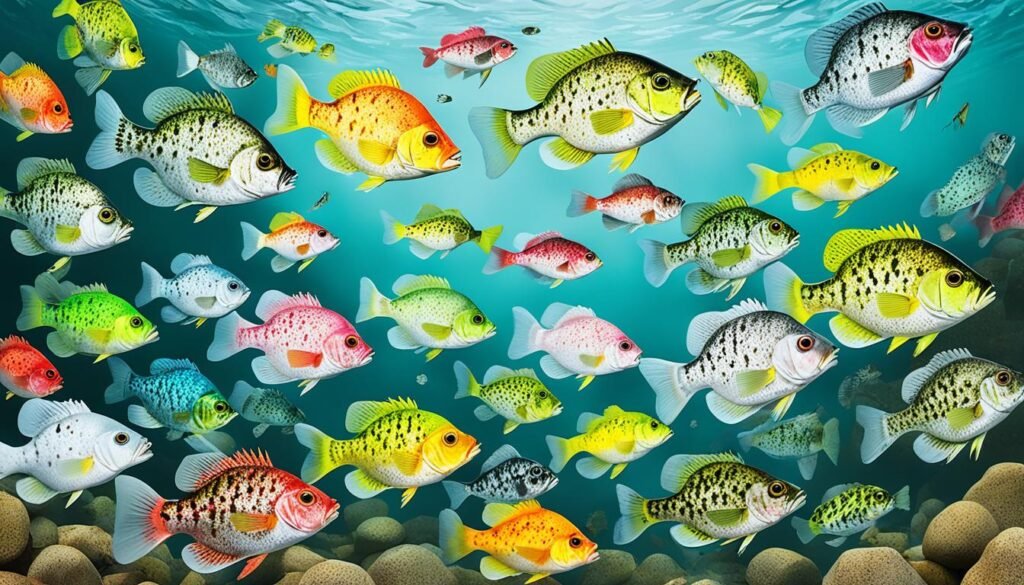
The Versatility of Bobby Garland Crappie Baits
Bobby Garland Crappie Baits, particularly the Baby Shad series, offers a wide range of color options. These baits have become favorites among anglers due to their versatility and effectiveness in catching crappies. Monkey Milk, Blue Ice, and Bluegrass are some of the top-selling colors in the Bobby Garland line.
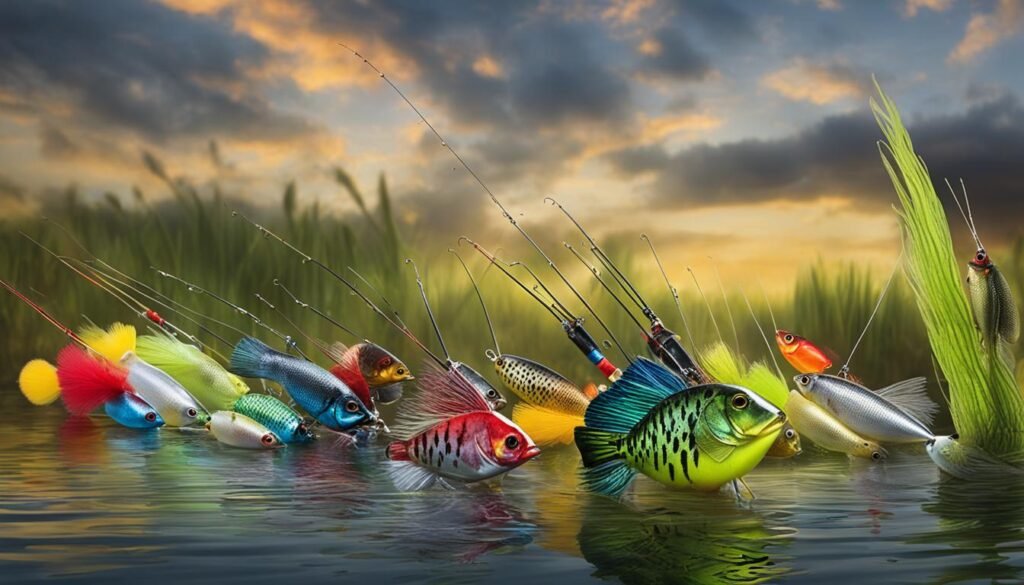
When it comes to crappie fishing, versatility is key. Anglers need lures that can adapt to different conditions and entice crappies in various scenarios. Bobby Garland Crappie Baits deliver on this need, offering a wide selection of colors that cater to different water clarities, lighting conditions, and fish preferences.
Bobby Garland’s Baby Shad series is particularly popular among crappie anglers. These soft plastic baits have the perfect combination of size, shape, and action to mimic the natural movements of baitfish, making them irresistible to hungry crappies. The Baby Shad’s versatility lies not only in its lifelike design but also in the wide range of colors available.
Anglers can choose from an extensive color palette to match the prevailing conditions. Whether it’s a sunny day on the water, fishing in clear water, or targeting crappies in muddy conditions, Bobby Garland Crappie Baits have a color that can effectively attract and trigger strikes.
One of the top-selling colors in the Bobby Garland line is Monkey Milk. This versatile color combines white and chartreuse, making it highly visible in both clear and murky water. Blue Ice is another popular choice, with its vibrant blue and silver combination that mimics the shimmer of baitfish. Anglers also swear by Bluegrass, a green pumpkin color that stands out in various water conditions.
Each color in the Bobby Garland Crappie Bait lineup has been carefully selected and tested to ensure its effectiveness. Experienced anglers have their go-to colors that consistently produce results, but it’s always worth experimenting and trying new combinations to find what works best in different fishing scenarios.
The versatility of Bobby Garland Crappie Baits extends beyond color selection. These lures can be fished in a multitude of ways, from casting and retrieving to vertical jigging and trolling. Anglers can adapt their techniques and presentations to match the behavior and preferences of crappies in different situations.
In summary, Bobby Garland Crappie Baits, especially the Baby Shad series, provide anglers with a versatile arsenal of colors and lure options. Whether you’re fishing in bright sunlight or murky waters, these baits have the versatility and effectiveness to entice crappies and maximize your chances of success.
The Science of Crappie Color Preferences
Research and studies have revealed fascinating insights into the intricate science behind crappie color preferences. The ability of crappies to perceive and respond to different colors is crucial in determining their feeding behavior. By understanding their color preferences, anglers can tailor their bait selection to maximize their chances of attracting strikes.
Color Vision and Decision Making
Crappies have remarkable visual capabilities that allow them to detect and distinguish various colors underwater. Their keen perception enables them to identify potential prey and make informed decisions on what to strike. This is particularly important when selecting the right bait color to tempt crappies into biting.
Environmental Influence
Crappie color preferences can vary depending on the environment they inhabit. In clear water conditions, crappies tend to be more selective and prefer natural-colored baits that closely resemble their natural forage. In contrast, in stained or muddy water, crappies rely more on their lateral line sense and may show a preference for darker and more contrasting colors.
Feeding Habits and Prey Imitation
Crappies primarily feed on small baitfish, insects, and invertebrates, and their color preferences often reflect the prey they target. Choosing bait colors that closely imitate the crappie’s preferred forage can be highly effective. By presenting a bait that mimics their natural prey, anglers can trigger a strong feeding response from crappies.
“Understanding the science of color preferences in crappies can help anglers unlock the hidden secrets of successful bait selection. By matching the right colors to the prevailing conditions and imitating the crappie’s preferred prey, we can dramatically increase our chances of landing a trophy catch.” – Expert Angler
Experimentation and Adaptation
While certain color preferences may be observed in crappies, it is important to remember that individual fish and specific fishing locations may exhibit unique behaviors. As anglers, it is crucial to experiment with different bait colors and observe how crappies respond. By adapting our strategies based on real-time observations, we can refine our color choices and optimize our fishing success.
| Environmental Condition | Preferred Bait Colors |
|---|---|
| Clear Water | Shades of white, gold flake, pearl |
| Stained or Muddy Water | Dark colors, black and chartreuse, black and hot pink |
| Sunny Days | Bright colors, chartreuse, hot pink, hot orange |
Building Your Crappie Color Selection
Selecting the right crappie lure color can be overwhelming due to the vast number of options available. It is essential to have a foundation of versatile colors to start with, such as Monkey Milk, Blue Ice, and Cajun Cricket. These colors have proven to be successful in a variety of conditions and are trusted by experienced anglers.
Monkey Milk, a popular choice among crappie anglers, features a combination of white, chartreuse, and silver flakes. This color works well in both clear and stained water, making it a versatile option for all-around fishing.
Blue Ice is another reliable color that mimics the appearance of a baitfish. With its blue body and silver flakes, it attracts the attention of crappies in clear water conditions. Anglers have reported great success with Blue Ice when targeting crappies in open water areas or near submerged structures.
Cajun Cricket is a darker color option that performs exceptionally well in stained or muddy water. Its black body and chartreuse tail create a strong contrast that enhances visibility in murky conditions, increasing your chances of enticing strikes from crappies.
Once you have established a foundation of versatile colors, you can start fine-tuning your selection based on specific conditions and fish preferences. Pay attention to factors such as water clarity, weather, time of day, and the behavior of the crappies you are targeting. By observing how crappies respond to different colors, you can refine your color selection and increase your success on the water.
Versatile Crappie Lure Colors
| Color | Description | Best Conditions |
|---|---|---|
| Monkey Milk | White, chartreuse, and silver flakes | All-around fishing, clear and stained water |
| Blue Ice | Blue body with silver flakes | Clear water, open areas, submerged structures |
| Cajun Cricket | Black body with chartreuse tail | Stained or muddy water |
By combining experimentation, observation, and knowledge of versatile colors, you can build a robust crappie color selection that increases your chances of success in various fishing conditions. Remember to remain adaptable and open to trying new colors based on the ever-changing behavior of crappies. With time and experience, you’ll become a master at selecting the perfect crappie lure color.
Crappie Lure Color Recommendations by Location
When it comes to crappie fishing, anglers from different regions have discovered the power of specific lure colors in various lakes and reservoirs. Each location presents unique conditions that can influence the effectiveness of certain colors. Here are some color recommendations based on successful experiences in specific locations:
Alabama’s Alabama River
Anglers targeting crappies in Alabama’s Alabama River have found that the following colors consistently produce results:
| Lure Color | Recommendations |
|---|---|
| Monkey Milk | A versatile color that imitates natural forage and attracts crappies in a variety of conditions. |
| Blue Ice | A unique color combination that stands out in the water and entices crappies to strike. |
| Electric Chicken | A vibrant color pattern that catches the attention of crappies, especially in stained water. |
Texas’s Lake Fork
Crappie enthusiasts fishing in Texas’s Lake Fork have had success with the following lure colors:
| Lure Color | Recommendations |
|---|---|
| Monkey Milk | A trusted color that consistently attracts crappies in various water conditions. |
| Blue Ice | A popular color choice that mimics the appearance of natural baitfish. |
| Electric Chicken | A high-contrast color combination that triggers strikes, particularly in muddy water. |
While these recommendations are specific to Alabama’s Alabama River and Texas’s Lake Fork, they can serve as a starting point for anglers targeting crappies in similar locations. Remember to take into account the prevailing conditions, such as water clarity and sunlight, as they can influence the visibility and effectiveness of different lure colors. Experimentation and observation are key to finding the perfect color combination that will entice crappies to bite.
Continue reading to discover expert picks for top crappie lure colors from anglers across the United States.
Conclusion
Selecting the right lure color for crappie fishing is a combination of science, experience, and observation. While there are no set rules, understanding the impact of color in different conditions can greatly improve your chances of success. Experiment with various colors, pay attention to how crappies respond, and adapt your strategy accordingly. With time and practice, you’ll develop your own go-to colors for different fishing scenarios.
